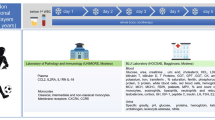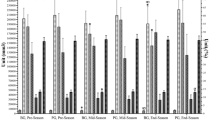Abstract
Intense exercise is known to cause temporary impairments in immune function. Few studies, however, have investigated the effects of intense competitive exercise on immunoendocrine variables in elite team sport athletes. The aim of this study was to evaluate the time course of changes in selected immunoendocrine and inflammatory markers following an international rugby union game. Blood samples were taken from players (n = 10) on camp entry, the morning of the game (pre), immediately after (post) and 14 and 38 h into a passive recovery period. Players lost 1.4 ± 0.2 kg of body mass during the game (ambient conditions, 11°C, 45% RH). An acute phase inflammatory response was observed as reflected through immediate increases in serum cortisol and IL-6 (post) followed by delayed increases in serum creatine kinase (CK; 14 h) activity and C-reactive protein (CRP; 38 h); P < 0.05. Decreases in the number of circulating T lympocytes, NK cells and bacteria-stimulated neutrophil degranulation were also observed post-exercise (P < 0.05), indicative of decreased host immune protection. Following a large decrease in serum testosterone to cortisol (T/C) ratio immediately post and 14 h after exercise, T/C values then increased above those observed at camp entry 38 h into recovery (P < 0.05). This rebound anabolic stimulus may represent a physiological requirement for recovery following intense tissue damage resulting from game collisions. The findings also suggest that a game of international rugby elicits disturbances in host immunity, which last up 38 h into the recovery period.



Similar content being viewed by others
References
Baker JS, Bailey DM, Hullin D, Young I, Davies B (2004) Metabolic implications of resistive force selection for oxidative stress and markers of muscle damage during 30 s of high-intensity exercise. Eur J Appl Physiol 92:321–327
Banfi G, Marinelli M, Roi GS, Agape V (1993) Usefulness of free testosterone/cortisol ratio during a season of elite speed skating athletes. Int J Sports Med 14:373–379
Bishop NC, Walsh NP, Scanlon GA (2003) Effect of prolonged exercise and carbohydrate on total neutrophil elastase content. Med Sci Sports Exerc 35:1326–1332
Blalock JE (1989) A molecular basis for bidirectional communication between the immune and neuroendocrine systems. Physiol Rev 69:1–32
Blannin AK, Gleeson M, Brooks B, Cave R (1996) Acute effects of exercise on human neutrophil degranulation. J Physiol 485P:140P
Brooks JHM, Fuller CW, Kemp SPT, Reddin DB (2008) An assessment of training volume in professional rugby union and its impact on the incidence, severity, and nature of match and training injuries. J Sports Sci 26:863–873
Bruunsgaard H, Hartkopp A, Mohr T, Konradsen H, Heron I, Mordhorst CH, Pedersen BK (1997) In vivo cell-mediated immunity and vaccination response following prolonged, intense exercise. Med Sci Sports Exerc 29:1176–1181
Clarkson PM, Hubal MJ (2002) Exercise-induced muscle damage in humans. Am J Phys Med Rehabil 81:S52–S69
Cooper MA, Fehniger TA, Caligiuri MA (2001) The biology of human natural killer-cell subsets. Trends Immunol 22:633–640
Cresswell SL, Eklund RC (2006) Changes in athlete burnout over a thirty-week rugby year. J Sci Med Sport 9:125–134
Cunniffe B, Proctor W, Baker JS, Davies B (2009) An evaluation of the physiological demands of elite rugby union using Global Positioning System tracking software. J Strength Cond Res 23:1195–1203
Deutsch MU, Kearney GA, Rehrer NJ (2007) Time–motion analysis of professional rugby union players during match play. J Sports Sci 25:461–472
Dill DB, Costill DL (1974) Calculation of percentage changes in volumes of blood, plasma and red cells in dehydration. J Appl Phyiol 37:247–248
Duthie G, Pyne D, Hooper S (2003) Applied physiology and game analysis of rugby union. Sports Med 33:973–991
Eaves S, Hughes M (2003) Patterns of play of international rugby union teams before and after the introduction of professional status. Int J Perform Anal 3:103–111
Elloumi M, Maso F, Michaux O, Robert A, Lac G (2003) Behaviour of saliva cortisol [C], testosterone [T] and the T/C ratio during a rugby match and during the post-competition recovery days. Eur J Appl Physiol 90:23–28
Faabri M, Smart C, Pardi R (2003) T lymphocytes. Int J Biochem Cell Biol 35:1004–1008
Fielding RA, Manfredi TJ, Ding W, Fiatarone MA, Evans WJ, Cannon JG (1993) Acute phase response in exercise. III. Neutrophil and IL-1 beta accumulation in skeletal muscle. Am J Physiol 265:R166–R172
Fuller CW, Brooks JH, Cancea RJ, Hall J, Kemp SP (2007) Contact events in rugby union and their propensity to cause injury. Br J Sports Med 4:862–867
Gleeson M (2007) Immune function in sport and exercise. J Appl Physiol 103:693–699
Gleeson M, Bishop NC (2005) The T cell and NK cell immune response to exercise. Ann Transplant 10:43–48
Gray AB, Telford RD, Weidemann MJ (1993) The effect of intense interval exercise on iron status parameters in trained men. Med Sci Sports Exerc 25:778–782
Hoffman JR, Maresh CM, Newton RU, Rubin MR, French DN, Volek JS, Sutherland J, Robertson M, Gómez AL, Ratamess NA, Kang J, Kraemer WJ (2002) Performance, biochemical, and endocrine changes during a competitive football game. Med Sci Sports Exerc 34:1845–1853
Hoffman JR, Kang J, Ratamess NA, Faigenbaum AD (2005) Biochemical and hormonal responses during an intercollegiate football season. Med Sci Sports Exerc 37:1237–1241
Hoogeveen AR, Zonderland ML (1996) Relationships between testosterone, cortisol and performance in professional cyclists. Int J Sports Med 17:423–428
Ispirlidis I, Fatouros IG, Jamurtas AZ, Nikolaidis MG, Michailidis I, Douroudos I, Margonis K, Chatzinikolaou A, Kalistratos E, Katrabasas I, Alexiou V, Taxildaris K (2008) Time course of changes in inflammatory and performance responses following a soccer game. Clin J Sport Med 18:423–431
Laing SJ, Jackson AR, Walters R, Lloyd-Jones E, Whitham M, Maassen N, Walsh NP (2008) Human blood neutrophil responses to prolonged exercise with and without a thermal clamp. J Appl Physiol 104:20–26
Malm C, Nyberg P, Engstrom M, Sjodin B, Lenkei R, Ekblom B, Lundberg I (2000) Immunological changes in human skeletal muscle and blood after eccentric exercise and multiple biopsies. J Physiol. 15:243–262
Mars M, Govender S, Weston A, Naicker V, Chuturgoon A (1998) High intensity exercise: a cause of lymphocyte apoptosis? Biochem Biophys Res Commun 249:366–370
Mashiko T, Umeda T, Nakaji S, Sugawara K (2004) Position-related analysis of the appearance of and relationship between post-match physical and mental fatigue in university rugby football players. Br J Sports Med 8:617–621
Passelergue P, Lac G (1999) Saliva cortisol, testosterone and T/C ratio variations during a wrestling competition and during the post-competitive recovery period. Int J Sports Med 20:109–113
Paulsen G, Benestad HB, Strøm-Gundersen I, Mørkrid L, Lappegård KT, Raastad T (2005) Delayed leukocytosis and cytokine response to high-force eccentric exercise. Med Sci Sports Exerc 37:1877–1883
Peake JM (2002) Exercise-induced alterations in neutrophil degranulation and respiratory burst activity: possible mechanisms of action. Exerc Immunol Rev 8:49–100
Pyne DB (1994) Regulation of neutrophil function during exercise. Sports Med 17:245–258
Quarrie KL, Hopkins WG (2007) Changes in player characteristics and match activities in Bledisloe Cup rugby union from 1972 to 2004. J Sports Sci 25:895–903
Roberts SP, Trewartha G, Higgitt RJ, El-Abd J, Stokes KA (2008) The physical demands of elite English rugby union. J Sports Sci 26:825–833
Robson PJ, Blannin AK, Walsh NP, Castell LM, Gleeson M (1999) Effects of exercise intensity, duration and recovery on in vitro neutrophil function in male athletes. Int J Sports Med 20:128–135
Ronsen O, Pedersen BK, Øritsland TR, Bahr R, Kjeldsen-Kragh J (2001) Leukocyte counts and lymphocyte responsiveness associated with repeated bouts of strenuous endurance exercise. J Appl Physiol 91:425–434
Scharhag J, Meyer T, Auracher M, Gabriel HH, Kindermann W (2006) Effects of graded carbohydrate supplementation on the immune response in cycling. Med Sci Sports Exerc 38:286–292
Sjödin B, Hellsten Westing Y, Apple FS (1990) Biochemical mechanisms for oxygen free radical formation during exercise. Sports Med 10:236–254
Smart DJ, Gill ND, Beaven CM, Cook CJ, Blazevich AJ (2008) The relationship between changes in interstitial creatine kinase and game-related impacts in rugby union. Br J Sports Med 42:198–201
Steensberg A, Fischer CP, Keller C, Møller K, Pedersen BK (2003) IL-6 enhances plasma IL-1ra, IL-10, and cortisol in humans. Am J Physiol Endocrinol Metab 285:E433–E437
Takahashi I, Umeda T, Mashiko T, Chinda D, Oyama T, Sugawara K, Nakaji S (2007) Effects of rugby sevens matches on human neutrophil-related non-specific immunity. Br J Sports Med 41:13–18
Takarada Y (2003) Evaluation of muscle damage after a rugby match with special reference to tackle plays. Br J Sports Med 37:416–419
Tidball JG (2005) Inflammatory processes in muscle injury and repair. Am J Physiol Regul Integr Comp Physiol 288:R345–R353
Torzewski M, Rist C, Mortensen RF, Zwaka TP, Bienek M, Waltenberger J, Koenig W, Schmitz G, Hombach V, Torzewski J (2000) C-reactive protein in the arterial intima: role of C-reactive protein receptor-dependent monocyte recruitment in atherogenesis. Arterioscler Thromb Vasc Biol 20:2094–2099
Zuliani U, Bonetti A, Franchini D, Serventi G, Ugolotti G, Varacca A (1985) Effect of boxing on some metabolic indices of muscular contraction. Int J Sports Med 6:234–236
Acknowledgments
We would like to thank Mr Lewis Fall, Mr John Woodside and Mr Kevin Evans of the University of Glamorgan for their help with data collection. Special thanks also to Mr Paul Jones and Mr Gareth Walters at University of Wales Institute Cardiff for assistance with data analysis and Dr Glen Davison (Aberystwyth University) for sound laboratory advice. Finally, we are very grateful to the players who kindly participated in this study and coordination of staff at the Wales Rugby Union. The authors declare that the experiments comply with the current laws of the country in which they were performed.
Conflict of interest statement
The authors of this manuscript declare that they have no conflict of interest.
Author information
Authors and Affiliations
Corresponding author
Rights and permissions
About this article
Cite this article
Cunniffe, B., Hore, A.J., Whitcombe, D.M. et al. Time course of changes in immuneoendocrine markers following an international rugby game. Eur J Appl Physiol 108, 113–122 (2010). https://doi.org/10.1007/s00421-009-1200-9
Accepted:
Published:
Issue Date:
DOI: https://doi.org/10.1007/s00421-009-1200-9




